park assist MERCEDES-BENZ ML SUV 2008 Owners Manual
[x] Cancel search | Manufacturer: MERCEDES-BENZ, Model Year: 2008, Model line: ML SUV, Model: MERCEDES-BENZ ML SUV 2008Pages: 381, PDF Size: 7.18 MB
Page 7 of 381
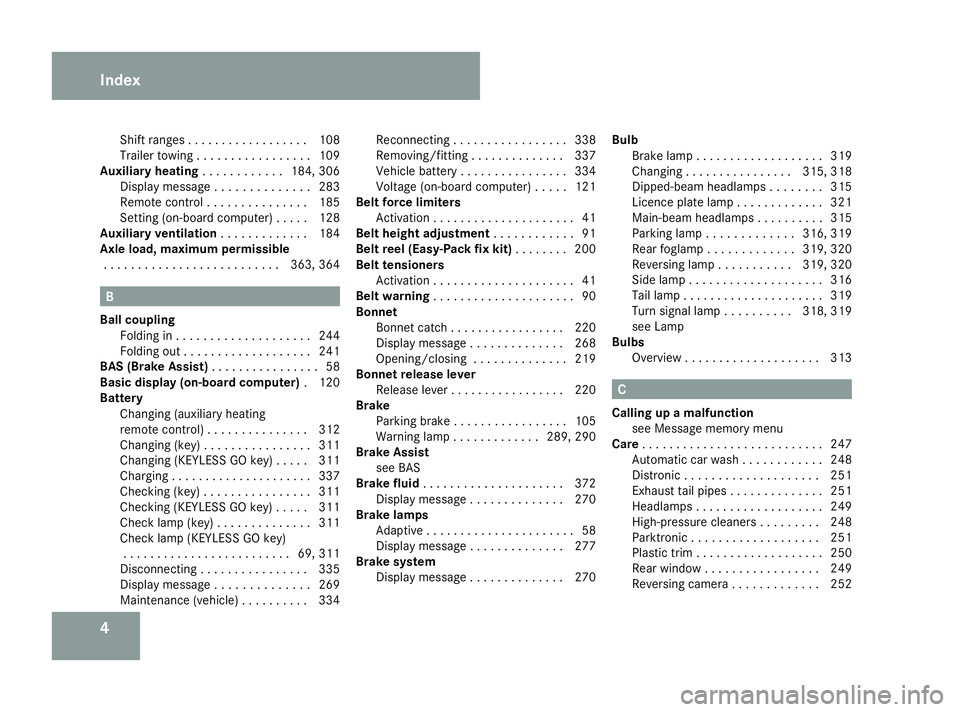
4Shift ranges . . . . . . . . . . . . . . . . .
.108
Trailer towing . . . . . . . . . . . . . . . . .109
Auxiliary heating . . . . . . . . . . ..184, 306
Display message . . . . . . . . . . . . . .283
Remote control . . . . . . . . . . . . . . .185
Setting (on-board computer) . . . . .128
Auxiliary ventilation . . . . . . . . . . . ..184
Axle load, maximum permissible
. . . . . . . . . . . . . . . . . . . . . . . . . .363, 364 B
Ball coupling Folding in . . . . . . . . . . . . . . . . . . . .244
Folding out . . . . . . . . . . . . . . . . . . .241
BAS (Brake Assist) . . . . . . . . . . . . . . ..58
Basic display (on-board computer) .120
Battery Changing (auxiliary heating
remote control) . . . . . . . . . . . . . . .312
Changing (key ).. . . . . . . . . . . . . . .311
Changing (KEYLESS GO key) . . . . .311
Charging . . . . . . . . . . . . . . . . . . . . .337
Checking (key ).. . . . . . . . . . . . . . .311
Checking (KEYLESS GO key) . . . . .311
Check lamp (key ).. . . . . . . . . . . . .311
Check lamp (KEYLESS GO key) . . . . . . . . . . . . . . . . . . . . . . . . .69, 311
Disconnecting . . . . . . . . . . . . . . . .335
Display message . . . . . . . . . . . . . .269
Maintenance (vehicle ).. . . . . . . ..334 Reconnecting . . . . . . . . . . . . . . . .
.338
Removing/fitting . . . . . . . . . . . . . .337
Vehicle battery . . . . . . . . . . . . . . . .334
Voltage (on-board computer) . . . . .121
Belt force limiters
Activatio n.. . . . . . . . . . . . . . . . . . . .41
Belt height adjustment . . . . . . . . . . ..91
Belt reel (Easy-Pack fix kit) . . . . . . ..200
Belt tensioners Activatio n.. . . . . . . . . . . . . . . . . . . .41
Belt warning . . . . . . . . . . . . . . . . . . . . .90
Bonnet Bonnet catch . . . . . . . . . . . . . . . . .220
Display message . . . . . . . . . . . . . .268
Opening/closing . . . . . . . . . . . . . .219
Bonnet release lever
Release lever . . . . . . . . . . . . . . . . .220
Brake
Parking brake . . . . . . . . . . . . . . . . .105
Warning lamp . . . . . . . . . . . . .289, 290
Brake Assist
see BAS
Brake fluid . . . . . . . . . . . . . . . . . . . . .372
Display message . . . . . . . . . . . . . .270
Brake lamps
Adaptive . . . . . . . . . . . . . . . . . . . . . .58
Display message . . . . . . . . . . . . . .277
Brake system
Display message . . . . . . . . . . . . . .270 Bulb
Brake lamp . . . . . . . . . . . . . . . . . . .319
Changing . . . . . . . . . . . . . . . .315, 318
Dipped-beam headlamps . . . . . . . .315
Licence plate lamp . . . . . . . . . . . . .321
Main-beam headlamps . . . . . . . . . .315
Parking lamp . . . . . . . . . . . . .316, 319
Rear foglamp . . . . . . . . . . . . .319, 320
Reversing lamp . . . . . . . . . . .319, 320
Side lamp . . . . . . . . . . . . . . . . . . . .316
Tail lamp . . . . . . . . . . . . . . . . . . . . .319
Turn signal lamp . . . . . . . . . .318, 319
see Lamp
Bulbs
Overview . . . . . . . . . . . . . . . . . . . .313 C
Calling up a malfunction see Message memory menu
Care . . . . . . . . . . . . . . . . . . . . . . . . . . .247
Automatic car wash . . . . . . . . . . . .248
Distronic . . . . . . . . . . . . . . . . . . . .251
Exhaust tail pipes . . . . . . . . . . . . . .251
Headlamps . . . . . . . . . . . . . . . . . . .249
High-pressure cleaners . . . . . . . . .248
Parktroni c.. . . . . . . . . . . . . . . . . .251
Plastic trim . . . . . . . . . . . . . . . . . . .250
Rear window . . . . . . . . . . . . . . . . .249
Reversing camera . . . . . . . . . . . . .252 Index
164_AKB; 5; 5, en-GB
wobuchh,
Version: 2.10.6 2008-05-11T11:55:12+02:00 - Seite 4Dateiname: 6515_4293_02_buchblock.pdf; preflight
Page 108 of 381
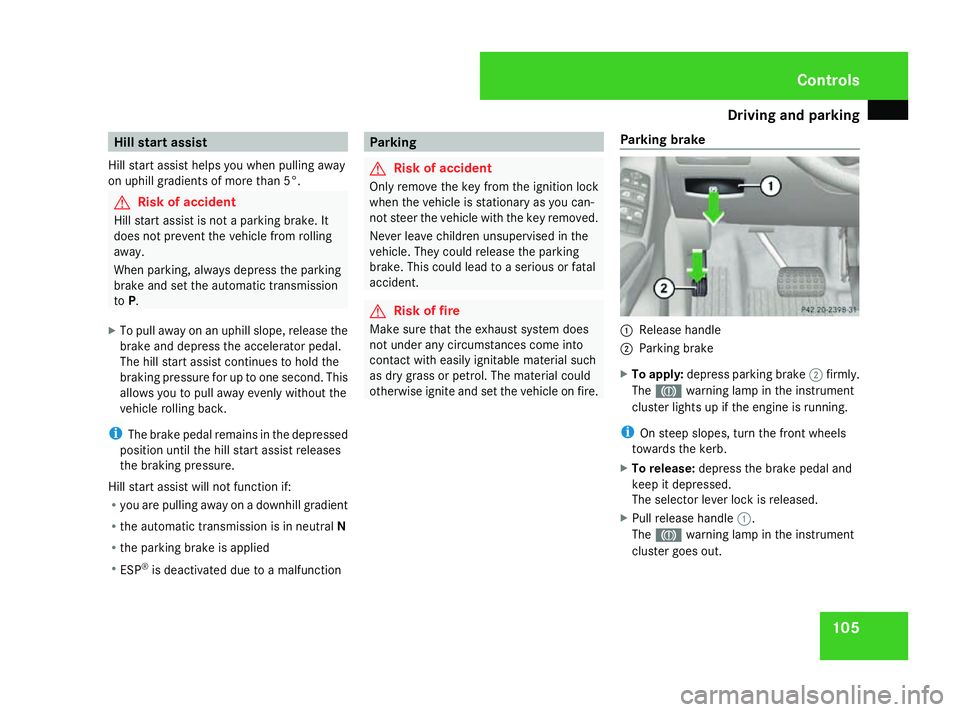
Driving and pa
rking 105Hill start assist
Hill start assist helps you when pulling away
on uphill gradients of more than 5°. G
Risk of accident
Hill start assist is not a parking brake. It
does not prevent the vehicle from rolling
away.
When parking, always depress the parking
brake and set the automatic transmission
to P.
X To pull away on an uphill slope, release the
brake and depress the accelerator pedal.
The hill start assist continues to hold the
braking pressure for up to one second. This
allows you to pull away evenly without the
vehicle rolling back.
i The brake pedal remains in the depressed
position until the hill start assist releases
the braking pressure.
Hill start assist will not function if:
R you are pulling away on a downhill gradient
R the automatic transmission is in neutral N
R the parking brake is applied
R ESP ®
is deactivated due to a malfunction Parking
G
Risk of accident
Only remove the key from the ignition lock
when the vehicle is stationary as you can-
not steer the vehicle with the key removed.
Never leave children unsupervised in the
vehicle. They could release the parking
brake. This could lead to a serious or fatal
accident. G
Risk of fire
Make sure that the exhaust system does
not under any circumstances come into
contact with easily ignitable material such
as dry grass or petrol. The material could
otherwise ignite and set the vehicle on fire. Parking brake 1
Release handle
2 Parking brake
X To apply: depress parking brake 2firmly.
The 3 warning lamp in the instrument
cluster lights up if the engine is running.
i On steep slopes, turn the front wheels
towards the kerb.
X To release: depress the brake pedal and
keep it depressed.
The selector lever lock is released.
X Pull release handle 1.
The 3 warning lamp in the instrument
cluster goes out. Controls
164_AKB; 5; 5, en-GB
wobuchh
,V ersion: 2.10.6
2008-05-11T11:55:12+02:00 - Seite 105 ZDateiname: 6515_4293_02_buchblock.pdf; preflight
Page 109 of 381
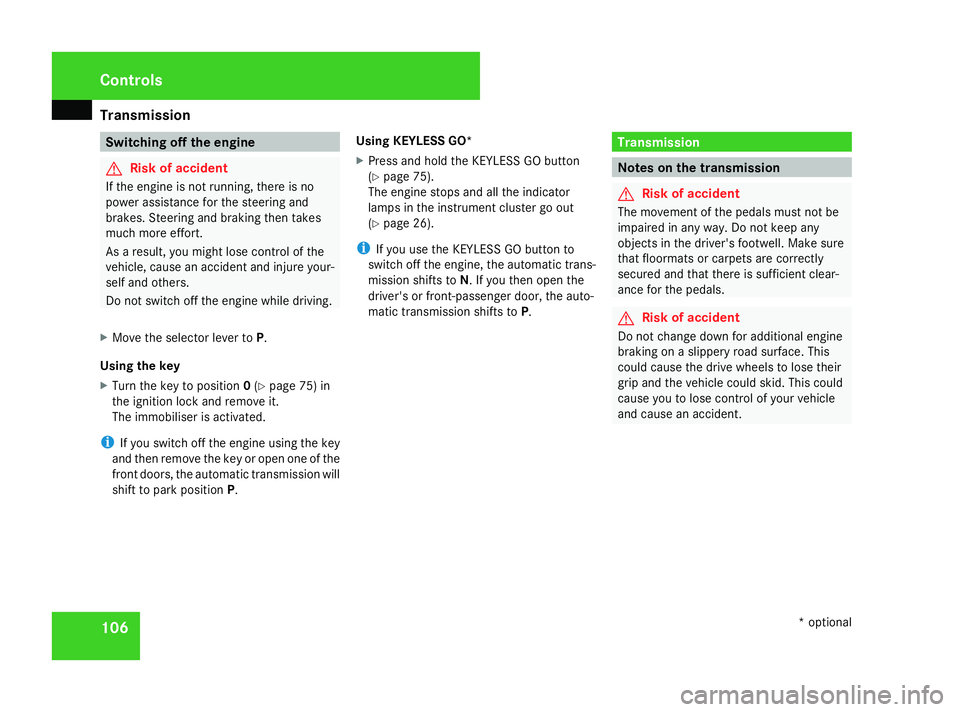
Transmission
106 Switching off the engine
G
Risk of accident
If the engine is not running, there is no
power assistance for the steering and
brakes. Steering and braking then takes
much more effort.
As a result, you might lose control of the
vehicle, cause an accident and injure your-
self and others.
Do not switch off the engine while driving.
X Move the selector lever to P.
Using the key
X Turn the key to position 0(Y page 75) in
the ignition lock and remove it.
The immobiliser is activated.
i If you switch off the engine using the key
and then remove the key or open one of the
front doors, the automatic transmission will
shift to park position P. Using KEYLESS GO*
X
Press and hold the KEYLESS GO button
(Y page 75).
The engine stops and all the indicator
lamps in the instrument cluster go out
(Y page 26).
i If you use the KEYLESS GO button to
switch off the engine, the automatic trans-
mission shifts to N. If you then open the
driver's or front-passenger door, the auto-
matic transmission shifts to P. Transmission
Notes on the transmission
G
Risk of accident
The movement of the pedals must not be
impaired in any way. Do not keep any
objects in the driver's footwell. Make sure
that floormats or carpets are correctly
secured and that there is sufficient clear-
ance for the pedals. G
Risk of accident
Do not change down for additional engine
braking on a slippery road surface. This
could cause the drive wheels to lose their
grip and the vehicle could skid. This could
cause you to lose control of your vehicle
and cause an accident. Controls
* optional
164_AKB; 5; 5, en-GB
wobuchh
,V ersion: 2.10.6
2008-05-11T11:55:12+02:00 - Seite 106 Dateiname: 6515_4293_02_buchblock.pdf; preflight
Page 141 of 381
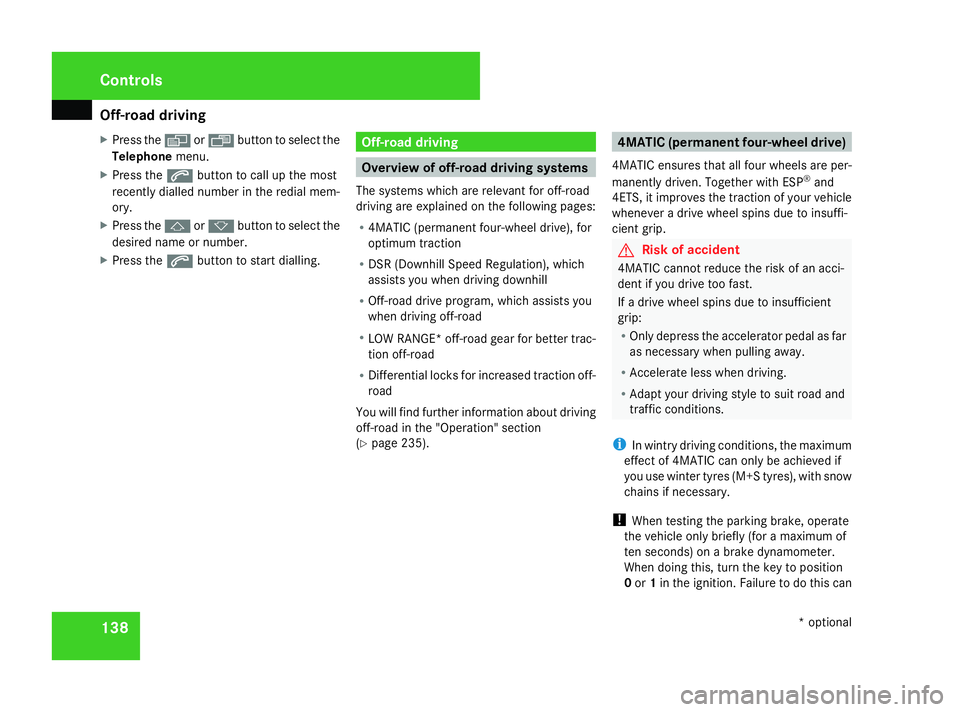
Off-road driving
138
X
Press the èor· button to select the
Telephone menu.
X Press the sbutton to call up the most
recently dialled number in the redial mem-
ory.
X Press the jork button to select the
desired name or number.
X Press the sbutton to start dialling. Off-road driving
Overview of off-road driving systems
The systems which are relevant for off-road
driving are explained on the following pages:
R 4MATIC (permanent four-wheel drive), for
optimum traction
R DSR (Downhill Speed Regulation), which
assists you when driving downhill
R Off-road drive program, which assists you
when driving off-road
R LOW RANGE* off-road gear for better trac-
tion off-road
R Differential locks for increased traction off-
road
You will find further information about driving
off-road in the "Operation" section
(Y page 235). 4MATIC (permanent four-wheel drive)
4MATIC ensures that all four wheels are per-
manently driven. Together with ESP ®
and
4ETS, it improves the traction of your vehicle
whenever a drive wheel spins due to insuffi-
cient grip. G
Risk of accident
4MATIC cannot reduce the risk of an acci-
dent if you drive too fast.
If a drive wheel spins due to insufficient
grip:
R Only depress the accelerator pedal as far
as necessary when pulling away.
R Accelerate less when driving.
R Adapt your driving style to suit road and
traffic conditions.
i In wintry driving conditions, the maximum
effect of 4MATIC can only be achieved if
you use winter tyres (M+S tyres), with snow
chains if necessary.
! When testing the parking brake, operate
the vehicle only briefly (for a maximum of
ten seconds) on a brake dynamometer.
When doing this, turn the key to position
0 or 1in the ignition. Failure to do this can Controls
* optional
164_AKB; 5; 5, en-GB
wobuchh,
Version: 2.10.6 2008-05-11T11:55:12+02:00 - Seite 138Dateiname: 6515_4293_02_buchblock.pdf; preflight
Page 148 of 381
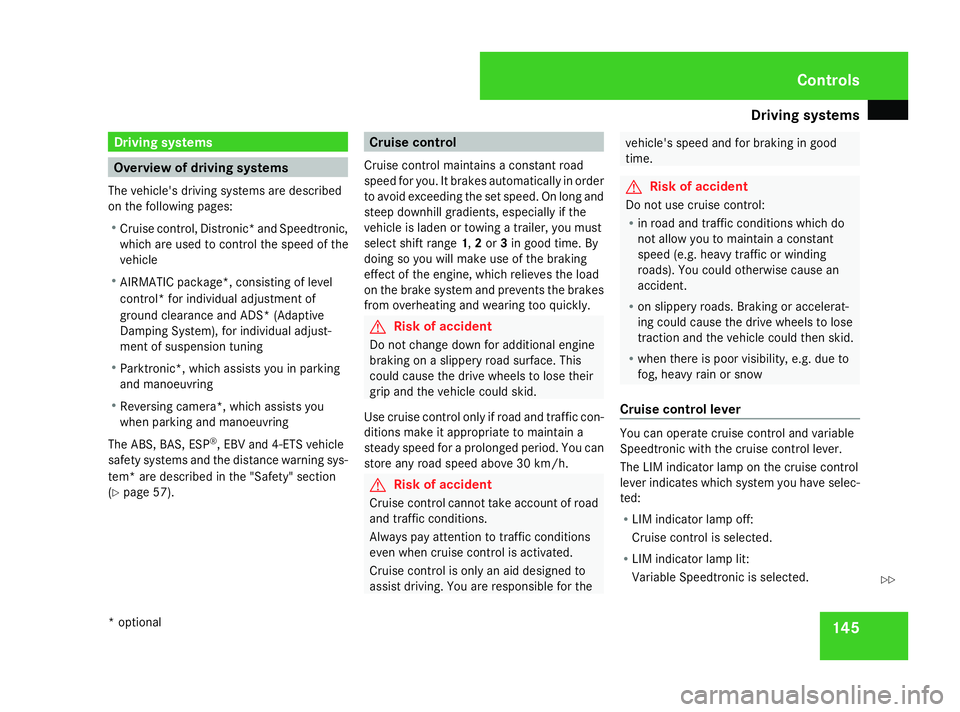
Driving sys
tems 145Driving systems
Overview of driving systems
The vehicle's driving systems are described
on the following pages:
R Cruise control, Distronic* and Speedtronic,
which are used to control the speed of the
vehicle
R AIRMATIC package*, consisting of level
control* for individual adjustment of
ground clearance and ADS* (Adaptive
Damping System), for individual adjust-
ment of suspension tuning
R Parktronic*, which assists you in parking
and manoeuvring
R Reversing camera*, which assists you
when parking and manoeuvring
The ABS, BAS, ESP ®
, EBV and 4-ETS vehicle
safety systems and the distance warning sys-
tem* are described in the "Safety" section
(Y page 57). Cruise control
Cruise control maintains a constant road
speed for you. It brakes automatically in order
to avoid exceeding the set speed. On long and
steep downhill gradients, especially if the
vehicle is laden or towing a trailer, you must
select shift range 1,2or 3in good time. By
doing so you will make use of the braking
effect of the engine, which relieves the load
on the brake system and prevents the brakes
from overheating and wearing too quickly. G
Risk of accident
Do not change down for additional engine
braking on a slippery road surface. This
could cause the drive wheels to lose their
grip and the vehicle could skid.
Use cruise control only if road and traffic con-
ditions make it appropriate to maintain a
steady speed for a prolonged period. You can
store any road speed above 30 km/h. G
Risk of accident
Cruise control cannot take account of road
and traffic conditions.
Always pay attention to traffic conditions
even when cruise control is activated.
Cruise control is only an aid designed to
assist driving. You are responsible for the vehicle's speed and for braking in good
time.
G
Risk of accident
Do not use cruise control:
R in road and traffic conditions which do
not allow you to maintain a constant
speed (e.g. heavy traffic or winding
roads). You could otherwise cause an
accident.
R on slippery roads. Braking or accelerat-
ing could cause the drive wheels to lose
traction and the vehicle could then skid.
R when there is poor visibility, e.g. due to
fog, heavy rain or snow
Cruise control lever You can operate cruise control and variable
Speedtronic with the cruise control lever.
The LIM indicator lamp on the cruise control
lever indicates which system you have selec-
ted:
R
LIM indicator lamp off:
Cruise control is selected.
R LIM indicator lamp lit:
Variable Speedtronic is selected. Controls
* optional
164_AKB; 5; 5, en-GB
wobuchh
,V ersion: 2.10.6
2008-05-11T11:55:12+02:00 - Seite 145 ZDateiname: 6515_4293_02_buchblock.pdf; preflight
Page 151 of 381
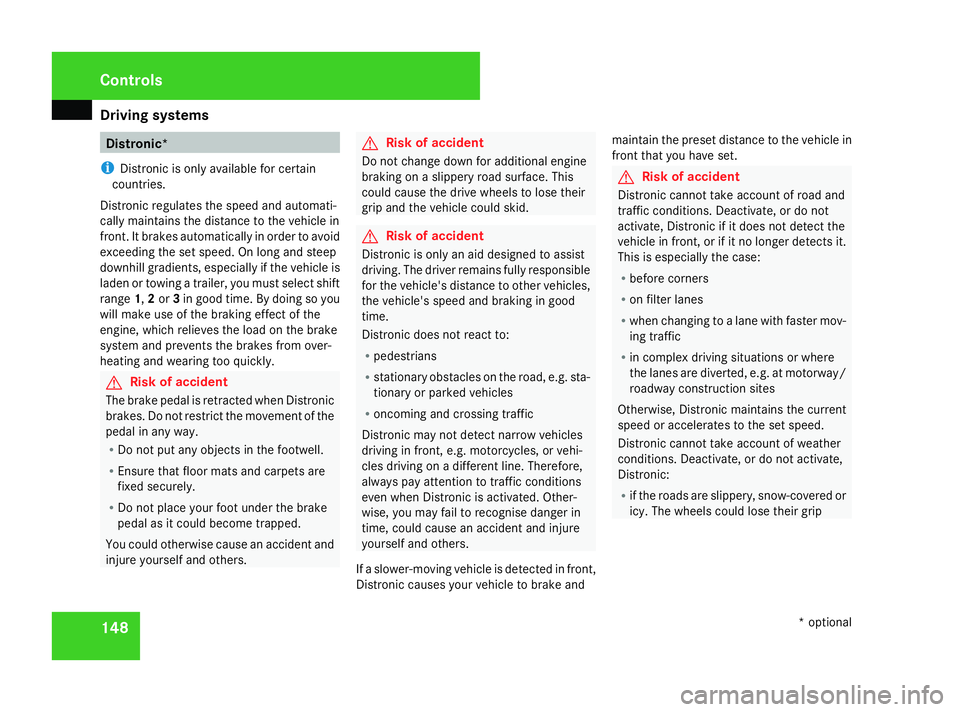
Driving sys
tems 148 Distronic*
i Distronic is only available for certain
countries.
Distronic regulates the speed and automati-
cally maintains the distance to the vehicle in
front. It brakes automatically in order to avoid
exceeding the set speed. On long and steep
downhill gradients, especially if the vehicle is
laden or towing a trailer, you must select shift
range 1,2or 3in good time. By doing so you
will make use of the braking effect of the
engine, which relieves the load on the brake
system and prevents the brakes from over-
heating and wearing too quickly. G
Risk of accident
The brake pedal is retracted when Distronic
brakes. Do not restrict the movement of the
pedal in any way.
R Do not put any objects in the footwell.
R Ensure that floor mats and carpets are
fixed securely.
R Do not place your foot under the brake
pedal as it could become trapped.
You could otherwise cause an accident and
injure yourself and others. G
Risk of accident
Do not change down for additional engine
braking on a slippery road surface. This
could cause the drive wheels to lose their
grip and the vehicle could skid. G
Risk of accident
Distronic is only an aid designed to assist
driving. The driver remains fully responsible
for the vehicle's distance to other vehicles,
the vehicle's speed and braking in good
time.
Distronic does not react to:
R pedestrians
R stationary obstacles on the road, e.g. sta-
tionary or parked vehicles
R oncoming and crossing traffic
Distronic may not detect narrow vehicles
driving in front, e.g. motorcycles, or vehi-
cles driving on a different line. Therefore,
always pay attention to traffic conditions
even when Distronic is activated. Other-
wise, you may fail to recognise danger in
time, could cause an accident and injure
yourself and others.
If a slower-moving vehicle is detected in front,
Distronic causes your vehicle to brake and maintain the preset distance to the vehicle in
front that you have set. G
Risk of accident
Distronic cannot take account of road and
traffic conditions. Deactivate, or do not
activate, Distronic if it does not detect the
vehicle in front, or if it no longer detects it.
This is especially the case:
R before corners
R on filter lanes
R when changing to a lane with faster mov-
ing traffic
R in complex driving situations or where
the lanes are diverted, e.g. at motorway/
roadway construction sites
Otherwise, Distronic maintains the current
speed or accelerates to the set speed.
Distronic cannot take account of weather
conditions. Deactivate, or do not activate,
Distronic:
R if the roads are slippery, snow-covered or
icy. The wheels could lose their grip Controls
* optional
164_AKB; 5; 5, en-GB
wobuchh
,V ersion: 2.10.6
2008-05-11T11:55:12+02:00 - Seite 148 Dateiname: 6515_4293_02_buchblock.pdf; preflight
Page 153 of 381
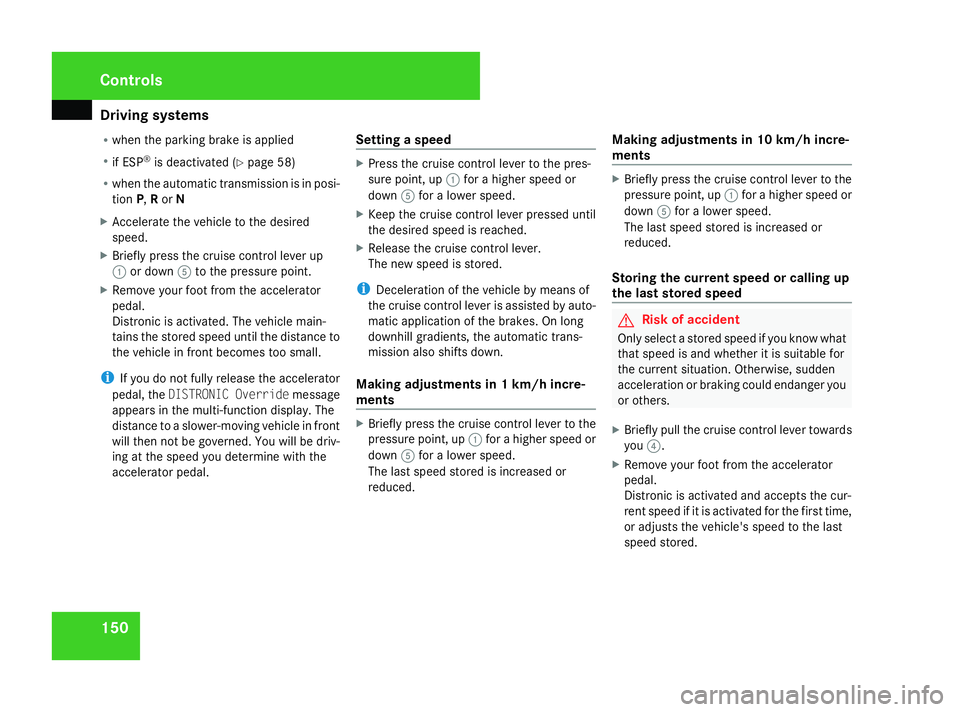
Driving sys
tems 150
R
when the parking brake is applied
R if ESP ®
is deactivated (Y page 58)
R when the automatic transmission is in posi-
tion P,Ror N
X Accelerate the vehicle to the desired
speed.
X Briefly press the cruise control lever up
1 or down 5to the pressure point.
X Remove your foot from the accelerator
pedal.
Distronic is activated. The vehicle main-
tains the stored speed until the distance to
the vehicle in front becomes too small.
i If you do not fully release the accelerator
pedal, the DISTRONIC Override message
appears in the multi-function display. The
distance to a slower-moving vehicle in front
will then not be governed. You will be driv-
ing at the speed you determine with the
accelerator pedal. Setting a speed X
Press the cruise control lever to the pres-
sure point, up 1for a higher speed or
down 5for a lower speed.
X Keep the cruise control lever pressed until
the desired speed is reached.
X Release the cruise control lever.
The new speed is stored.
i Deceleration of the vehicle by means of
the cruise control lever is assisted by auto-
matic application of the brakes. On long
downhill gradients, the automatic trans-
mission also shifts down.
Making adjustments in 1 km/h incre-
ments X
Briefly press the cruise control lever to the
pressure point, up 1for a higher speed or
down 5for a lower speed.
The last speed stored is increased or
reduced. Making adjustments in 10 km/h incre-
ments X
Briefly press the cruise control lever to the
pressure point, up 1for a higher speed or
down 5for a lower speed.
The last speed stored is increased or
reduced.
Storing the current speed or calling up
the last stored speed G
Risk of accident
Only select a stored speed if you know what
that speed is and whether it is suitable for
the current situation. Otherwise, sudden
acceleration or braking could endanger you
or others.
X Briefly pull the cruise control lever towards
you 4.
X Remove your foot from the accelerator
pedal.
Distronic is activated and accepts the cur-
rent speed if it is activated for the first time,
or adjusts the vehicle's speed to the last
speed stored. Controls
164_AKB; 5; 5, en-GB
wobuchh
,V ersion: 2.10.6
2008-05-11T11:55:12+02:00 - Seite 150 Dateiname: 6515_4293_02_buchblock.pdf; preflight
Page 326 of 381
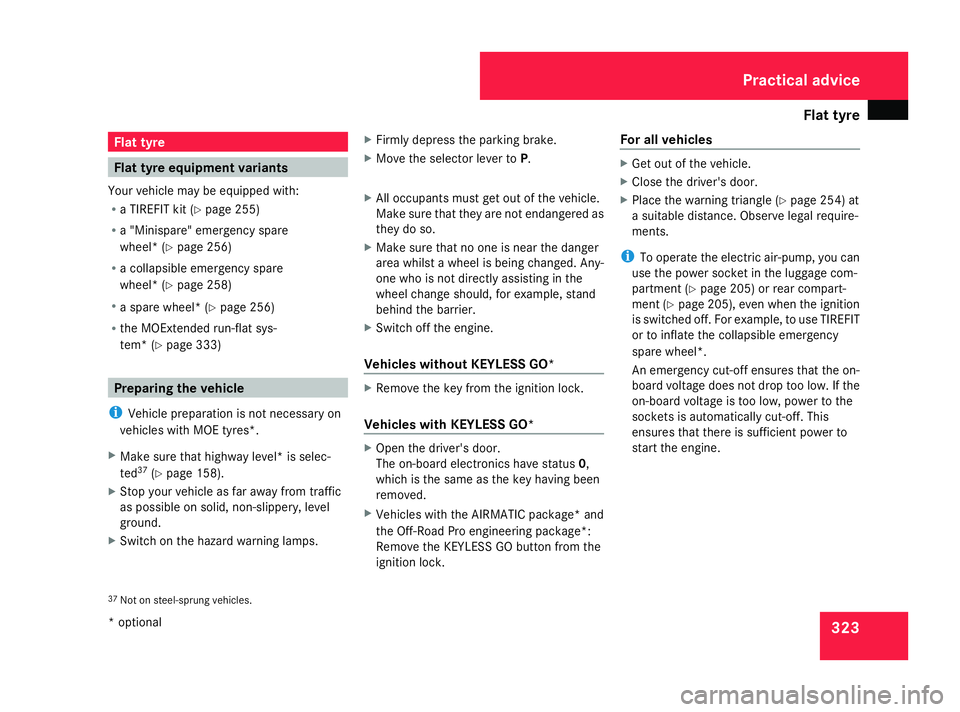
Flat tyre
323Flat tyre
Flat tyre equipment variants
Your vehicle may be equipped with:
R a TIREFIT kit (Y page 255)
R a "Minispare" emergency spare
wheel* (Y page 256)
R a collapsible emergency spare
wheel* (Y page 258)
R a spare wheel* (Y page 256)
R the MOExtended run-flat sys-
tem* (Y page 333) Preparing the vehicle
i Vehicle preparation is not necessary on
vehicles with MOE tyres*.
X Make sure that highway level* is selec-
ted 37
(Y page 158).
X Stop your vehicle as far away from traffic
as possible on solid, non-slippery, level
ground.
X Switch on the hazard warning lamps. X
Firmly depress the parking brake.
X Move the selector lever to P.
X All occupants must get out of the vehicle.
Make sure that they are not endangered as
they do so.
X Make sure that no one is near the danger
area whilst a wheel is being changed. Any-
one who is not directly assisting in the
wheel change should, for example, stand
behind the barrier.
X Switch off the engine.
Vehicles without KEYLESS GO* X
Remove the key from the ignition lock.
Vehicles with KEYLESS GO* X
Open the driver's door.
The on-board electronics have status 0,
which is the same as the key having been
removed.
X Vehicles with the AIRMATIC package* and
the Off-Road Pro engineering package*:
Remove the KEYLESS GO button from the
ignition lock. For all vehicles X
Get out of the vehicle.
X Close the driver's door.
X Place the warning triangle ( Ypage 254) at
a suitable distance. Observe legal require-
ments.
i To operate the electric air-pump, you can
use the power socket in the luggage com-
partment (Y page 205) or rear compart-
ment (Y page 205), even when the ignition
is switched off. For example, to use TIREFIT
or to inflate the collapsible emergency
spare wheel*.
An emergency cut-off ensures that the on-
board voltage does not drop too low. If the
on-board voltage is too low, power to the
sockets is automatically cut-off. This
ensures that there is sufficient power to
start the engine.
37 Not on steel-sprung vehicles. Practical advice
* optional
164_AKB; 5; 5, en-GB
wobuchh,
Version: 2.10.6 2008-05-11T11:55:12+02:00 - Seite 323 ZDateiname: 6515_4293_02_buchblock.pdf; preflight